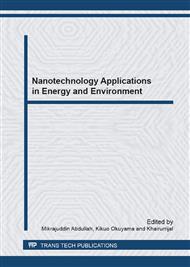[1]
F. Grosselle, G.Timelli, F. Bonollo,Doe applied to microstructural and mechanical properties of Al–Si–Cu–Mg casting alloys for automotive applications, Mater.Sci. and Eng. A 527 (2010) 3536-3545.
DOI: 10.1016/j.msea.2010.02.029
Google Scholar
[2]
A. Blackmore, K. Morton, Structure-property relationships in graphitic cast irons, Int. Journal of Fatigue 4 (1982) 149-155.
DOI: 10.1016/0142-1123(82)90042-1
Google Scholar
[3]
S. Roskosz, J. Adamiec, Methodology of quantitative evaluation of porosity, dendrite arm spacing and grain size in directionally solidified blades made of CMSX-6 nickel alloy, Mater. Characterization 60 (2009) 1120-1126.
DOI: 10.1016/j.matchar.2009.01.024
Google Scholar
[4]
Y. hui Wei, L.feng Hou, B.-she Xu, Martensite in die-cast magnesium alloy?, J. of Alloys and Compounds 467 (2009) 130-134.
DOI: 10.1016/j.jallcom.2007.11.101
Google Scholar
[5]
Y.H. Cho, A.K. Dahle, Correlation between hydrogen migration and microstructure in cast Mg alloys, J.of Alloys and Compounds 509 (2011) S621-S624.
DOI: 10.1016/j.jallcom.2010.10.123
Google Scholar
[6]
C.S. Lim, A.J. Clegg, N.L. Loh, The reduction of dendrite ARM spacing using a novel pressure-assisted investment casting approach, J. Mater. Proc. Tech. 70 (1997) 99-102.
DOI: 10.1016/s0924-0136(97)00044-7
Google Scholar
[7]
K.B. Kim, J. Das, W. Löser, M.H. Lee, D.H. Kim, S.K. Roy, J. Eckert, Microstructural comparison of Zr73.5Nb9Cu7Ni1Al9.5 nanostructure-dendrite composites produced by different casting techniques, Mater. Sci. and Eng. A 449–451 (2007) 747-751.
DOI: 10.1016/j.msea.2006.02.370
Google Scholar
[8]
D. Casellas, R. Pérez, J.M. Prado, Fatigue variability in Al–Si cast alloys, Mater. Sci. and Eng. A 398 (2005) 171-179.
DOI: 10.1016/j.msea.2005.03.034
Google Scholar
[9]
W.R. Osório, J.E. Spinelli, N.Cheung, A. Garcia, Secondary dendrite arm spacing and solute redistribution effects on the corrosion resistance of Al–10 wt% Sn and Al–20 wt% Zn alloys, Mater. Sci. and Eng. A 420 (2006) 179-186.
DOI: 10.1016/j.msea.2006.01.058
Google Scholar
[10]
P.Choudhury, K. Das, S. Das, Evolution of as-cast and heat-treated microstructure of a commercial bearing alloy, Mater. Sci. and Eng. A 398 (2005) 332-343.
DOI: 10.1016/j.msea.2005.03.098
Google Scholar
[11]
Z. Zhang, X. Bian, Y. Wang, Growth of dendrites in a rapidly solidified Al-23 Sr alloy, J. of Cryst. Growth 243 (2002) 531-538.
DOI: 10.1016/s0022-0248(02)01580-4
Google Scholar
[12]
D.Y. Li, L.Q. Chen, Selective variant growth of coherent precipitate under external constraints, J. Phase Equilib. 19 (1998) 523–528.
DOI: 10.1361/105497198770341707
Google Scholar
[13]
J.W. Cahn, S.C. Han, G.B. McFadden, Anisotropy of Interfaces in an Ordered HCP Binary Alloy, J. Stat. Phys. 95 (1999) 1337–1360.
DOI: 10.6028/nist.ir.6217
Google Scholar
[14]
R.D. Ramdan, T. Takaki, K. Yashiro, Y. Tomita, The Effects of Structure Orientation on the Growth of Fe2B Boride by Multi-Phase-Field Simulation, Mater. Trans. 51 (2010) 62–67.
DOI: 10.2320/matertrans.m2009227
Google Scholar
[15]
E.R. Wang, X.D. Hui, S.S. Wang, Y.F. Zhao, G.L. Chen, Improved mechanical properties in cast Al–Si alloys by combined alloying of Fe and Cu, Mater. Sci. and Eng. A 527 (2010) 7878-7884.
DOI: 10.1016/j.msea.2010.08.058
Google Scholar
[16]
A.M.A. Mohamed, A.M. Samuel, F.H. Samuel, H.W. Doty, Influence of additives on the microstructure and tensile properties of near-eutectic Al–10.8%Si cast alloy, Mater. & Design 30 (2009) 3943-3957.
DOI: 10.1016/j.matdes.2009.05.042
Google Scholar
[17]
A. Yamanaka, T. Takaki and Y. Tomita, PF Simulation of Austenite to Ferrite Transform and Widmanstatten Ferrite formation in Fe-C Alloy Mater.Trans. 47 (2006) 2725–2731.
DOI: 10.2320/matertrans.47.2725
Google Scholar


